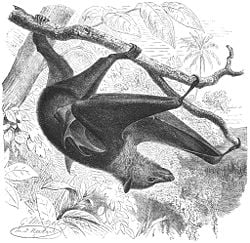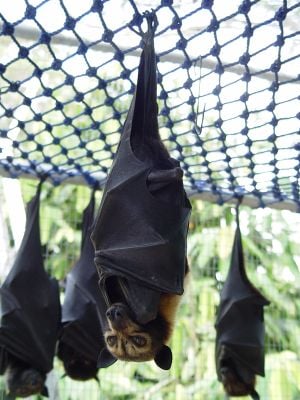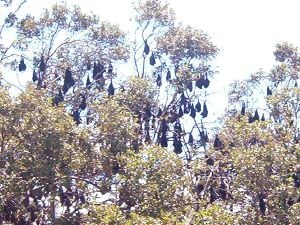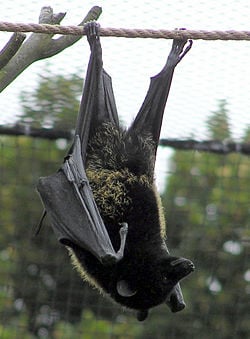Difference between revisions of "Megabat" - New World Encyclopedia
Rick Swarts (talk | contribs) |
Rick Swarts (talk | contribs) |
||
| Line 36: | Line 36: | ||
[[Bat]]s are flying mammals that comprise the order Chiroptera. | [[Bat]]s are flying mammals that comprise the order Chiroptera. | ||
| − | Typically, [[bat]]s, which comprise the [[mammal]]ian order [[Chiroptera]], are divided into two distinct groups | + | Typically, [[bat]]s, which comprise the [[mammal]]ian order [[Chiroptera]], are divided into two distinct groups that generally are given the rank of suborders: Megachiroptera, or megabats, and Microchiroptera, or microbats. These two groups may not represent monophyletic lineages, but taxonomies generally reflect this division (Wund and Myers 2005). The names imply that megabats are larger than microbats, but this is true only in a general sense, as some megabat species are smaller than some microbat species. There are, however, several consistent differences between these two groups. |
| − | + | Among the differences between megabats and microbats is the fact that the later use [[Animal echolocation|echolocation]], whereas megabats generally do not (except for ''[[Rousettus]]'' and relatives); microbats lack the [[claw]] at the second [[toe]] of the [[forelimb]] characteristic of all but one of the megabats; and megachiropterans tend to have large prominent eyes, unlike the generally small eyes of the echolocating microbats. Furthermore, the ears of the microbats tend to have large pinnae (external ears) and the ears do not form a closed ring, but the edges are separated from each other at the base of the ear. Megabats also tend to have a diet of [[fruit]], [[nectar]] or [[pollen]], only supplementing their diets with a few insects, while most microbats eat [[insect]]s. | |
| − | Megabats range in size from species with adults only about 6 [[centimetre|centimeters]] (2.4 [[inch]]es) long and 13 grams to species that reach 40 centimeters (16 inches) in length, attain a [[wingspan]] of 150 centimeters (5 [[Foot (unit of length)|feet]]), and weigh nearly 1 [[kilogram|kilogram]] (more than 2 [[Pound (mass)|pounds]]). The large eyes of most fruit bats allow them to orient visually in the [[twilight]] of dusk and inside [[cave]]s and [[forest]]s. | + | Megabats range in size from species with adults only about 6 [[centimetre|centimeters]] (2.4 [[inch]]es) long and 13 grams to species that reach 40 centimeters (16 inches) in length, attain a [[wingspan]] of 150 centimeters (5 [[Foot (unit of length)|feet]]), and weigh nearly 1 [[kilogram|kilogram]] (more than 2 [[Pound (mass)|pounds]]). The large eyes of most fruit bats allow them to orient visually in the [[twilight]] of dusk and inside [[cave]]s and [[forest]]s. The [[sense of smell]] is excellent in megabats. |
| − | + | ===Diet=== | |
| − | |||
| − | |||
| − | |||
| − | ==Diet== | ||
[[Image:flying foxes.jpg|thumb|left|thumb|Fox Island, Australia, is believed to be the largest colony of flying foxes on the continent]] | [[Image:flying foxes.jpg|thumb|left|thumb|Fox Island, Australia, is believed to be the largest colony of flying foxes on the continent]] | ||
| − | Fruit bats are [[frugivore|frugivorous]] or [[nectarivore|nectarivorous]], | + | Fruit bats are [[frugivore|frugivorous]] or [[nectarivore|nectarivorous]], in other words, they eat [[fruit]]s or lick [[nectar (plant)|nectar]] from [[flower]]s. Often the fruits are crushed and only the [[Fruit juices|juices]] consumed. The [[tooth|teeth]] are adapted to bite through hard fruit skins. Large fruit bats must land in order to eat fruit, while the smaller species are able to hover with flapping wings in front of a flower or fruit. |
==Importance== | ==Importance== | ||
Revision as of 03:46, 19 October 2008
| Megabats
| ||||||||||||
|---|---|---|---|---|---|---|---|---|---|---|---|---|
 Large flying fox, Pteropus vampyrus
| ||||||||||||
| Scientific classification | ||||||||||||
| ||||||||||||
|
Macroglossinae |
Megabat is the common name for any of the largely herbivorous Old World bats comprising the suborder Megachiroptera of the order Chiroptera (bats), characterized by true wings and flight (as with all bats), large and prominent eyes, generally claws on the second digits supporting the wings, and an excellent sense of smell. Echolocation is almost unknown among the megabats, while it is prominent in the other major division of bats, the microbats comprising the suborder Microchiroptera.
Extant megabats are placed in one family, Pteropodidae, which has about 170 species. These species are found in Africa, Asia, and Oceania. Megabats primarily feed on fruit, nectar, or pollen. These flying mammals are also referred to as fruit bats, old world fruit bats, or flying foxes, or more specifically as Megachiropteran fruit bats.
pollination
Overview and description
Bats are flying mammals that comprise the order Chiroptera.
Typically, bats, which comprise the mammalian order Chiroptera, are divided into two distinct groups that generally are given the rank of suborders: Megachiroptera, or megabats, and Microchiroptera, or microbats. These two groups may not represent monophyletic lineages, but taxonomies generally reflect this division (Wund and Myers 2005). The names imply that megabats are larger than microbats, but this is true only in a general sense, as some megabat species are smaller than some microbat species. There are, however, several consistent differences between these two groups.
Among the differences between megabats and microbats is the fact that the later use echolocation, whereas megabats generally do not (except for Rousettus and relatives); microbats lack the claw at the second toe of the forelimb characteristic of all but one of the megabats; and megachiropterans tend to have large prominent eyes, unlike the generally small eyes of the echolocating microbats. Furthermore, the ears of the microbats tend to have large pinnae (external ears) and the ears do not form a closed ring, but the edges are separated from each other at the base of the ear. Megabats also tend to have a diet of fruit, nectar or pollen, only supplementing their diets with a few insects, while most microbats eat insects.
Megabats range in size from species with adults only about 6 centimeters (2.4 inches) long and 13 grams to species that reach 40 centimeters (16 inches) in length, attain a wingspan of 150 centimeters (5 feet), and weigh nearly 1 kilogram (more than 2 pounds). The large eyes of most fruit bats allow them to orient visually in the twilight of dusk and inside caves and forests. The sense of smell is excellent in megabats.
Diet
Fruit bats are frugivorous or nectarivorous, in other words, they eat fruits or lick nectar from flowers. Often the fruits are crushed and only the juices consumed. The teeth are adapted to bite through hard fruit skins. Large fruit bats must land in order to eat fruit, while the smaller species are able to hover with flapping wings in front of a flower or fruit.
Importance
Frugivorous bats aid the distribution of plants (and therefore, forests) by carrying the fruits with them and spitting the seeds or eliminating them elsewhere. Nectarivores actually pollinate visited plants. They bear long tongues that are inserted deep into the flower; pollen thereby passed to the bat is then transported to the next blossom visited, pollinating it. This relationship between plants and bats is a form of mutualism known as chiropterophily. Examples of plants that benefit from this arrangement include the baobabs of the genus Adansonia and the sausage tree (Kigelia).
Classification
Bats are usually thought to belong to one of two monophyletic groups, a view that is reflected in their classification into two suborders (Megachiroptera and Microchiroptera). According to this hypothesis, all living megabats and microbats are descendants of a common ancestor species that was already capable of flight. However, there have been other views, and a vigorous debate persists to this date. For example, in the 1980s and 1990s, some researchers proposed (based primarily on the similarity of the visual pathways) that the Megachiroptera were in fact more closely affiliated with the primates than the Microchiroptera, with the two groups of bats having therefore evolved flight via convergence (see Flying primates theory).[1] However, a recent flurry of genetic studies confirms the more longstanding notion that all bats are indeed members of the same clade, the Chiroptera.[2][3] Other studies have recently suggested that certain families of microbats (possibly the horseshoe bats, mouse-tailed bats and the false vampires) are evolutionarily closer to the fruit bats than to other microbats.[2][4]
Mindoro Stripe-Faced Fruitbat
On September 17, 2007, a new species of flying fox, or fruit bat — orange-coloured with a distinctive, white-striped face — was discovered in a protected wildlife area in the Sablayan region, Mindoro, Philippines. The Mindoro Stripe-Faced Fruitbat was discovered through a joint research effort by the University of Kansas's Biodiversity Research Center and the Comparative Biogeography and Conservation of Philippine Vertebrates (CBCPV). The Journal of Mammalogy published its details. The total number of bat species in the Philippines is 74, with 26 unique to the Philippines.[5]
List of genera
The family Pteropodidae is divided into two subfamilies with 173 total species, represented by 42 genera:
Subfamily Macroglossinae
- Macroglossus (long-tongued fruit bats)
- Megaloglossus (Woermann's Bat)
- Eonycteris (dawn fruit bats)
- Syconycteris (blossom bats)
- Melonycteris
- Notopteris (long-tailed fruit bat)
Subfamily Pteropodinae
- Eidolon (straw-coloured fruit bats)
- Rousettus (rousette fruit bats)
- Boneia (considered subgenus of Rousettus by most authors[6]
- Myonycteris (little collared fruit bats)
- Pteropus (flying foxes)
- Acerodon (including Giant golden-crowned flying fox)
- Neopteryx
- Pteralopex
- Styloctenium
- Dobsonia (bare-backed fruit bats)
- Aproteles (Bulmer's fruit bat)
- Harpyionycteris (Harpy Fruit Bat)
- Plerotes (D'Anchieta's Fruit Bat)
- Hypsignathus (Hammer-headed bat)
- Epomops (epauleted bats)
- Epomophorus (epauleted fruit bats)
- Micropteropus (dwarf epauleted bats)
- Nanonycteris (Veldkamp's Bat)
- Scotonycteris
- Casinycteris (Short-palated Fruit Bat)
- Cynopterus (dog-faced fruit bats or short-nosed fruit bats)
- Megaerops
- Ptenochirus (musky fruit bats)
- Dyacopterus (Dayak fruit bats)
- Chironax (black-capped fruit bat)
- Thoopterus (Swift Fruit Bat)
- Sphaerias (Blanford's Fruit Bat)
- Balionycteris (spotted-winged fruit bat)
- Aethalops (pygmy fruit bat)
- Penthetor (dusky fruit bats)
- Haplonycteris (Fischer's pygmy fruit bat or Philippine dwarf fruit bat)
- Otopteropus (Luzon dwarf fruit bat)
- Alionycteris (Mindanao dwarf fruit bat)
- Latidens (Salim Ali's fruit bat)
- Nyctimene (tube-nosed fruit bat)
- Paranyctimene (lesser tube-nosed fruit bats)
- Mirimiri (Fijian Monkey-faced Bat)
Fruit bats in popular culture
Because of their large size and somewhat "spectral" appearance, fruit bats are sometimes used in horror movies to represent vampires or to otherwise lend an aura of spookiness. In reality, as noted above, the bats of this group are purely herbivorous creatures and pose no direct threat to human beings, baby cows, or ill children. Some works of fiction are more in line with this fact, portraying fruit bats as sympathetic or even featuring them as characters. For example, in the book series Silverwing by Kenneth Oppel, a fruit bat named Java is one of the main characters in the final book of the series. In Stellaluna, a popular children's book by Janell Cannon, the story revolves around the plight of a young fruit bat who is separated from her mother.
Bacardi Rum also uses the fruit bat as their trademark symbol.
Like any other animal, humans are sometimes likened to fruit bats due to appearance or mannerisms. Some examples:
- Guitarist Les Carter of the bands Carter USM and Abdoujaparov goes by the stage name of Fruitbat. His full nickname is Johnny Guitar Fruitbat, The Flying Fox.
See also
- Mammals of Borneo
- Cynopterus
- Penthetor
Footnotes
- ↑ Pettigrew JD, Jamieson BG, Robson SK, Hall LS, McAnally KI, Cooper HM, 1989, Phylogenetic relations between microbats, megabats and primates (Mammalia: Chiroptera and Primates). Philosophical Transactions of the Royal Society of London, Series B, Biological Sciences 325(1229):489-559
- ↑ 2.0 2.1 Eick, GN; Jacobs, DS; Matthee, CA (Sep 2005). A nuclear DNA phylogenetic perspective on the evolution of echolocation and historical biogeography of extant bats (chiroptera). Molecular biology and evolution 22 (9): 1869–86.
- ↑ Primitive Early Eocene bat from Wyoming and the evolution of flight and echolocation. Nature (2008-02-14). Retrieved 2008-07-03.
- ↑ Adkins RM, Honeycutt RL (1991). Molecular phylogeny of the superorder Archonta. Proceedings of the National Academy of Sciences of the U.S.A. 88 (22): 10317–10321.
- ↑ New bat species discovered in Philippines Yahoo.com.
- ↑ Mammal Species of the World - Browse: bidens
ReferencesISBN links support NWE through referral fees
James M. Hutcheon1 Contact Information and Theodore Garland Jr [http://www.springerlink.com/content/j186577190385878/
Are Megabats Big?
Journal Journal of Mammalian Evolution Publisher Springer Netherlands ISSN 1064-7554 (Print) 1573-7055 (Online) Issue Volume 11, Numbers 3-4 / December, 2004 DOI 10.1023/B:JOMM.0000047340.25620.89 Pages 257-277
Wund, M. and P. Myers. 2005. "Chiroptera" (On-line), Animal Diversity Web. Accessed October 18, 2008 at http://animaldiversity.ummz.umich.edu/site/accounts/information/Chiroptera.html.
- Myers, P. 2001. "Pteropodidae" (On-line), Animal Diversity Web. Accessed December 26, 2006 at http://animaldiversity.ummz.umich.edu/site/accounts/information/Pteropodidae.html.
- Springer, M. S. and et al (28 January 2005). A Molecular Phylogeny for Bats Illuminates Biogeography and the Fossil Record. Science 307: 580.
- Bat World Sanctuary
- Rodrigues Fruit Bats
- Bat Conservation International
- Criticism of the molecular evidence for bat monophyly
- Brief history of Megachiroptera / Megabats
External links
- Bat World Sanctuary
- Rodrigues Fruit Bats
- Bat Conservation International
- Brief history of Megachiroptera / Megabats
Credits
New World Encyclopedia writers and editors rewrote and completed the Wikipedia article in accordance with New World Encyclopedia standards. This article abides by terms of the Creative Commons CC-by-sa 3.0 License (CC-by-sa), which may be used and disseminated with proper attribution. Credit is due under the terms of this license that can reference both the New World Encyclopedia contributors and the selfless volunteer contributors of the Wikimedia Foundation. To cite this article click here for a list of acceptable citing formats.The history of earlier contributions by wikipedians is accessible to researchers here:
The history of this article since it was imported to New World Encyclopedia:
Note: Some restrictions may apply to use of individual images which are separately licensed.


